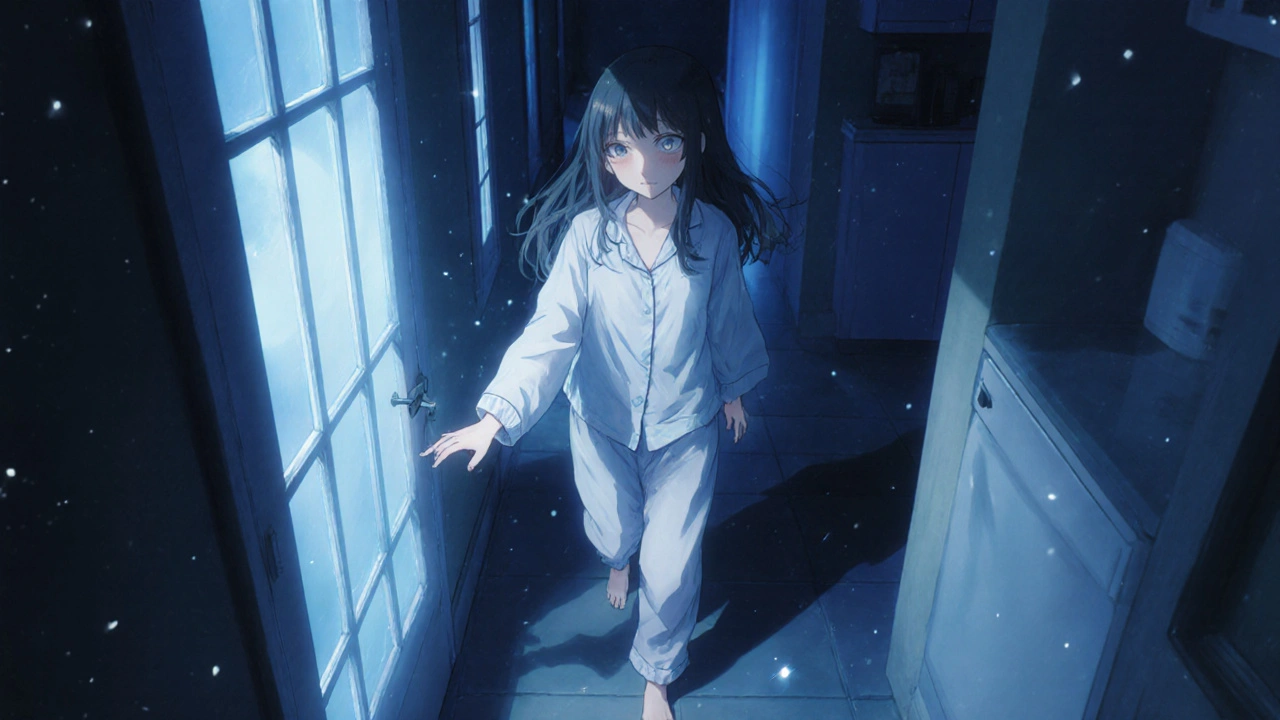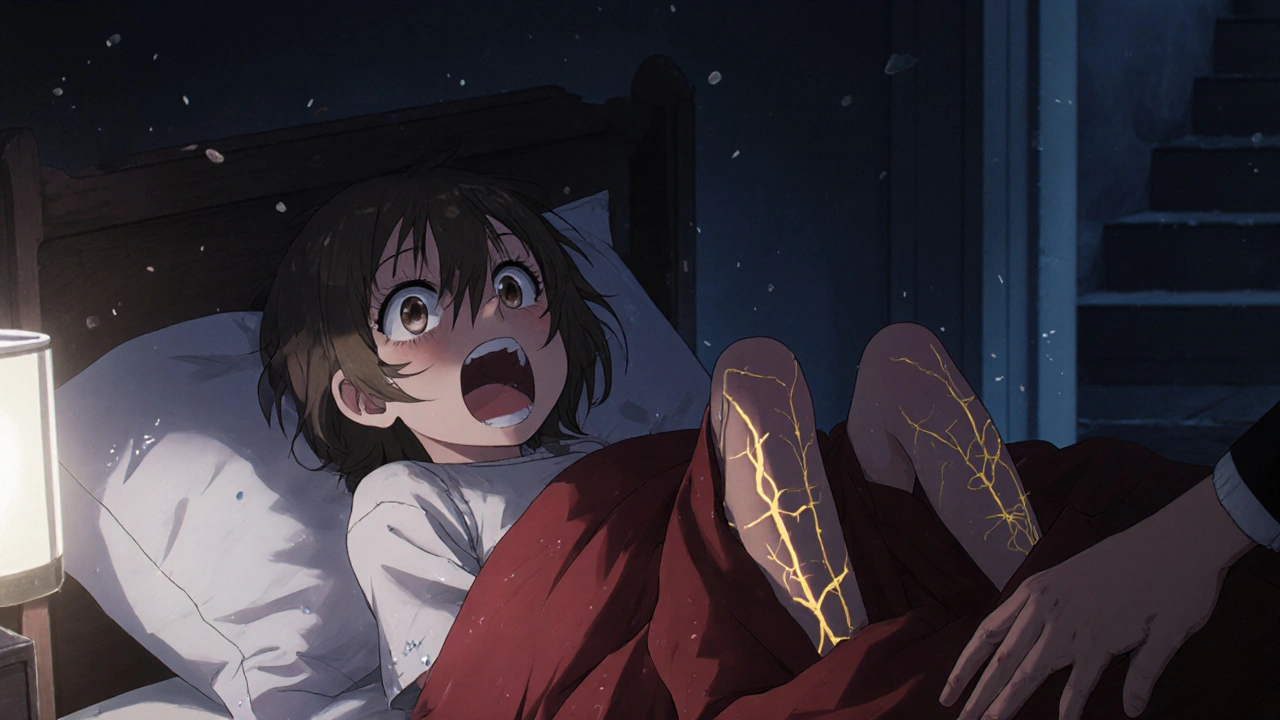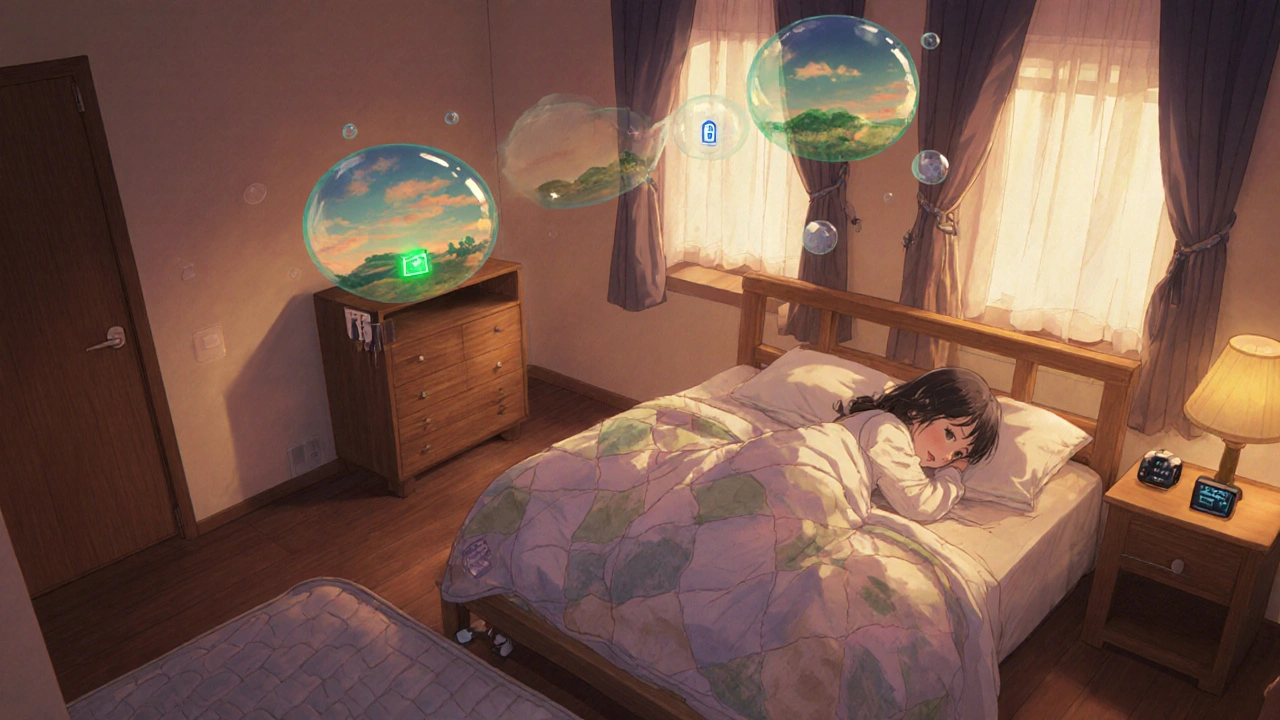Sleepwalking and Night Terrors: How to Manage Parasomnia Safely and Effectively
 Nov, 14 2025
Nov, 14 2025
Imagine waking up in the kitchen at 3 a.m., holding a knife, with no memory of how you got there. Or your child screaming, eyes wide open, heart pounding-completely unresponsive to your voice-then falling back asleep as if nothing happened. These aren’t nightmares. They’re parasomnias: abnormal behaviors during sleep that can be frightening, dangerous, and deeply confusing for everyone involved.
Sleepwalking and night terrors are two of the most common types of parasomnias, both arising from deep non-REM sleep. They’re not caused by stress alone, bad dreams, or poor parenting. They’re neurological events tied to how the brain transitions between sleep stages. And while they’re often dismissed as something kids ‘grow out of,’ they can persist into adulthood-and in some cases, signal something more serious.
What’s Really Happening During a Sleepwalking or Night Terror Episode?
Sleepwalking and night terrors both happen during slow-wave sleep, the deepest stage of non-REM sleep, usually within the first 90 to 120 minutes after falling asleep. That’s why they rarely happen in the early morning hours.
During a night terror, the brain’s fear centers go into overdrive. The body reacts like it’s under attack: heart rate spikes to 120-140 beats per minute, breathing quickens, sweat pours out, and pupils dilate. The person may sit bolt upright, scream, thrash, or even run-but they’re not dreaming. They’re stuck between sleep and wakefulness, completely unaware of their surroundings. Most won’t remember any of it the next day.
Sleepwalking is different in behavior but similar in origin. Instead of screaming, the person gets up and walks, sometimes performing complex tasks: opening cabinets, dressing, eating, or even driving. One documented case involved a man who cooked a full meal and cleaned the kitchen before returning to bed. He had no recollection of it. About 80% of these episodes happen in the first third of the night, when slow-wave sleep is strongest.
Unlike nightmares-which happen in REM sleep and leave you with vivid memories-parasomnias leave you with blank spots. That’s why people often think they’re fine until someone else tells them what happened.
Who Gets These Episodes-and When Should You Worry?
Sleepwalking affects 1-15% of children, peaking between ages 4 and 8. Night terrors hit slightly earlier, peaking at ages 3 to 7. In most cases, they fade by adolescence. About 80% of childhood sleepwalking cases and 90% of night terrors disappear by age 15.
But if it starts in adulthood? That’s a red flag. Adult-onset parasomnias are rare-and often linked to underlying conditions like sleep apnea, restless legs syndrome, depression, PTSD, or even neurological disorders like Parkinson’s. A 2023 study found that 30-40% of adults who suddenly begin sleepwalking or having night terrors have an undiagnosed sleep disorder.
Here’s when to seek help:
- Episodes happen more than twice a week
- There’s physical injury-falls, cuts, burns, or wandering outside
- Episodes last longer than 15 minutes
- Confusion lasts more than 15 minutes after waking
- There’s violent behavior-hitting, kicking, or attacking someone
- It starts after age 10, especially if it’s new
These aren’t just ‘weird sleep quirks.’ They’re warning signs that something’s off in the brain’s sleep-wake circuitry.
Safety First: The #1 Thing You Must Do
Before anything else-medication, therapy, sleep schedules-fix the environment. Most injuries from parasomnias are preventable.
Start with these steps:
- Install door alarms (under $30) that sound when the bedroom door opens
- Lock all windows and secure them with childproof latches
- Remove sharp objects, glass tables, and trip hazards from the bedroom
- Place the mattress directly on the floor to reduce fall injuries by up to 75%
- Use a baby monitor or camera to watch for early signs of arousal
- Keep car keys, tools, and weapons locked away
One parent on a sleep forum shared how their child once walked out the front door in pajamas at 2 a.m. The door alarm saved them. Another family found their teen had opened the garage door and was about to start the car. They didn’t know he’d been sleepwalking for months.
Safety isn’t optional. It’s the first and most important treatment.
Scheduled Awakenings: The Most Effective Behavioral Fix
If episodes happen at roughly the same time every night, scheduled awakenings can stop them in their tracks.
Here’s how it works:
- Track episodes for 1-2 weeks. Note the exact time they usually start.
- Set an alarm to wake the person 15-30 minutes before that time.
- Gently wake them fully-don’t just pat them. Talk to them, turn on a light, have them sit up for 30 seconds.
- Let them go back to sleep.
- Do this every night for 7-14 days.
This interrupts the deep sleep cycle just before the episode usually occurs. Studies show it works in 70-80% of cases. It’s not magic-it’s timing. You’re essentially resetting the brain’s internal alarm clock.
Parents report this is the most effective method they’ve tried. One mother in Philadelphia used it for her 6-year-old who had nightly night terrors. After two weeks, episodes dropped from 7 per week to zero-and stayed gone.

More Sleep, Fewer Episodes
Think you’re getting enough sleep? You might not be.
Deep sleep builds up the longer you’re awake. If someone is sleep-deprived, their brain tries to catch up by going deeper faster-increasing the chance of an arousal event. That’s why sleepwalking and night terrors spike during exams, travel, or illness.
Dr. Carlos Schenck’s research found that adding just 30-60 minutes of extra sleep per night reduced episodes by 65% in children. For adults, it’s the same: aim for 7-9 hours consistently.
Try this:
- Go to bed and wake up at the same time every day-even weekends
- Keep your bedroom cool (60-67°F)
- Avoid screens 1 hour before bed
- Don’t drink caffeine after 2 p.m.
One man on a sleep forum increased his sleep from 6.5 to 8.5 hours over eight weeks. His weekly sleepwalking episodes went from five to zero. No medication. Just more rest.
When Medication Might Help (and When It Won’t)
Most people don’t need drugs. But in severe cases-especially when safety is at risk-medication can be a bridge.
Clonazepam (a benzodiazepine) is the most studied drug for night terrors. It reduces episodes in 60-70% of cases. But it’s not a long-term fix. After 3 months, 30% of users develop tolerance. It can cause drowsiness, dizziness, and dependence.
Melatonin is a safer alternative. It helps regulate sleep timing and reduces episode frequency in 40-50% of cases. Doses of 3-6 mg taken 30 minutes before bed are common. It’s not a sedative-it’s a sleep signal.
For adults with suspected sleep apnea, treating the apnea often eliminates the parasomnia. One study showed that after starting CPAP therapy, 80% of patients saw night terrors vanish.
Bottom line: Medication is a last resort. Use it only if safety is compromised and behavioral changes haven’t worked after 6-8 weeks.
What Doesn’t Work (and Why)
Many people try the wrong things:
- Waking someone during an episode-This can make them more confused, agitated, or even violent. Don’t try to restrain them. Gently guide them back to bed.
- Scolding or punishing-They’re not doing this on purpose. Shaming them increases anxiety, which can make episodes worse.
- Just waiting it out-If it’s adult-onset or frequent, waiting can delay diagnosis of something more serious like sleep apnea or epilepsy.
- Herbal supplements like valerian or chamomile-No strong evidence they help parasomnias. They might help general sleep, but not the brain’s arousal mechanism.
Also, don’t assume it’s psychological. While stress can trigger episodes, it’s rarely the root cause. Most sleep specialists now treat these as neurological, not psychiatric.

What’s New in Parasomnia Treatment
In 2022, the FDA approved the first device specifically for night terrors: the Nightware System. It’s an Apple Watch app that detects rising heart rate variability-the early sign of an impending episode-and gently vibrates to interrupt it before the person fully wakes. In trials, it cut episodes by 35% over six months.
Digital CBT programs like Sleepio now include parasomnia modules. A 2023 study showed an 48% drop in sleepwalking episodes after an 8-week app-based program.
And genetics? Researchers have found a link between a gene called DEC2 and inherited sleepwalking. If you have a family history, your risk is higher. That’s why some clinics now offer genetic screening for recurrent cases.
These aren’t sci-fi. They’re real tools becoming available now.
When to See a Sleep Specialist
You don’t need to suffer in silence. A sleep specialist can:
- Order a sleep study (polysomnography) to confirm the diagnosis
- Rule out sleep apnea, seizures, or other conditions
- Recommend tailored behavioral plans
- Prescribe medication safely if needed
Most insurance plans cover sleep studies if symptoms are frequent or dangerous. If your doctor says, ‘It’s just a phase,’ ask for a referral to a sleep center. There are over 7,800 certified sleep specialists in the U.S.-and many specialize in parasomnias.
Don’t wait until someone gets hurt. Early intervention changes outcomes.
Final Thoughts: It’s Manageable, Not a Life Sentence
Sleepwalking and night terrors are scary-but they’re not hopeless. Most children outgrow them. Most adults can control them with simple, consistent steps.
The key is action: safety first, sleep second, schedule third, medication last. Track episodes. Adjust routines. Protect your home. And don’t be afraid to ask for help.
There’s no shame in needing support. Millions of families have been here. And with the right approach, peace-and safety-can return to the bedroom.

Jennifer Walton
November 15, 2025 AT 15:06It’s not about willpower. It’s about neural misfires. The brain doesn’t care if you’re ‘strong’ or ‘disciplined.’ It just glitches.
Kihya Beitz
November 17, 2025 AT 02:30Oh wow, another ‘sleep is broken’ article. Next up: ‘How to stop breathing while sleeping (it’s not sleep apnea, it’s your fault).’ 😴
Hollis Hollywood
November 17, 2025 AT 21:43I’ve been watching my sister sleepwalk for years. She used to make sandwiches, rearrange the living room, even try to feed the cat with a fork. One time she walked into the garage and tried to start the lawnmower. We didn’t know until my mom found her standing there at 4 a.m., covered in grass clippings, whispering to the engine like it was a person. I didn’t realize how much fear was just… normal until I read this. The part about door alarms? We should’ve done that years ago. I feel guilty. But also grateful someone finally explained it without making it sound like a horror movie.
Aidan McCord-Amasis
November 18, 2025 AT 06:10Just lock the damn knives and go to bed earlier. 🤷♂️
Adam Dille
November 19, 2025 AT 08:04This is actually super helpful. I didn’t know scheduled awakenings worked that well. My cousin’s kid had night terrors and we thought it was just ‘bad dreams.’ Turns out, waking them up gently before the usual time? Total game-changer. Also, the part about sleep apnea being linked? Mind blown. Gonna suggest my buddy gets tested - he’s been snoring like a chainsaw and now wakes up confused every morning. 🙌
Katie Baker
November 19, 2025 AT 22:19Thank you for writing this. I used to feel so alone thinking my kid’s episodes were ‘bad parenting.’ Now I know it’s biology, not failure. And the safety tips? So practical. I’m buying door alarms tomorrow. 💙
John Foster
November 20, 2025 AT 22:37Consider the implications. The brain, in its most vulnerable state - unconscious, defenseless - becomes a vessel for primal, unfiltered impulses. This isn’t sleepwalking. This is the subconscious breaking through the thin membrane of social conditioning. We call it a disorder, but what if it’s a glimpse into the raw architecture of the mind? The knife in the kitchen? The car in the garage? These aren’t accidents. They’re metaphors. The body remembers what the mind refuses to acknowledge. And we lock the doors, install alarms, schedule awakenings - all while ignoring the deeper question: What is the sleeper trying to escape? Not from the room. From themselves.
Edward Ward
November 22, 2025 AT 04:57Just to clarify: the 2023 study referenced - was it peer-reviewed? And which journal? Also, the Nightware System - I checked their website, and their trial size was only 47 participants, with no control group. And the genetic link to DEC2? That’s from a 2011 paper with a sample of 12 families. I’m not dismissing the advice - the safety tips are solid - but the ‘science’ here feels like a curated highlight reel. We need more nuance. For example, REM sleep behavior disorder is often misdiagnosed as night terrors, and it’s way more dangerous. Also, melatonin dosing: 3–6 mg is high for kids. The AAP recommends 0.3–1 mg. Please be more precise. I’m not trying to be a jerk - I just want people to make informed decisions.
Andrew Eppich
November 22, 2025 AT 08:10It is unfortunate that modern society has come to treat such serious neurological phenomena as mere inconveniences to be managed with alarms and melatonin. In my youth, families would have sought spiritual counsel, not smartphone apps. The decline in moral discipline is reflected in our sleep. One does not solve a breach of the natural order with a vibrating watch. The body is not a machine to be calibrated. It is a temple. And when it fails, we must examine the soul, not the schedule.
Jessica Chambers
November 23, 2025 AT 18:48My mom used to scream at my brother during his night terrors. ‘Stop it! You’re doing this on purpose!’ 😒 I’m glad we’re moving past that. Also, I just bought the Nightware app. Let’s see if it works better than my yelling.
Shyamal Spadoni
November 25, 2025 AT 02:02Wake up sheeple. This is all a psyop. The government implanted the sleep disruption tech in your wifi routers to monitor your dreams. They don’t want you to remember what you see when you’re unconscious. That’s why they push ‘melatonin’ and ‘sleep studies’ - it’s all a cover. The real cure? Unplug everything. Sleep in a Faraday cage. And stop using smartphones. They’re tracking your brainwaves. I’ve been sleepwalking since 2017 and I know. The knives? They’re not real. The car? It’s a simulation. The alarm? It’s a signal. They’re trying to wake you up… but not to reality. To their version of it. #WakeUp #SleepIsTheMatrix